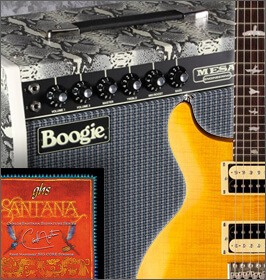Like most influential guitarists, Carlos Santana’s tone is a combination of three elements: his personal playing technique, his guitar (including pick choices), and his electronic equipment (including amp, effects, and speaker cabinets).
As Carlos’ career has evolved, so has his tone. He has gone through several stages, from the raw, unpolished sound of the debut album, Santana, to the much more polished and studio-controlled tones of his “collaboration” trio: Supernatural, Shaman, and All That I Am.
Signature Sound
Although many guitarists attempt to recreate a master’s sound by duplicating his (or her) equipment, the bald truth is that an enormous amount of a guitar player’s sound is in his hands. You could take Eric Clapton, Eric Johnson, Jimmy Page, Neal Schon, and B.B. King (to name a few), and put them in front of the exact same equipment; each would sound quite different.
Conversely, you could combine an accomplished six-string slinger like Jeff Beck with numerous different gear packages, and the result would always sound like Jeff.
 Forever Man
Forever Man
There are several outstanding features of Santana’s playing technique that help to produce his unique signature. One of the most obvious is his use of long, sustained notes without vibrato.
Carlos rarely employs vibrato. When he does, it is often the less-used vertical vibrato (moving the finger back and forth in parallel with the neck, as opposed to perpendicular to the neck). And his renowned sustained notes, held with a “straight tone” (sans vibrato), immediately identify him.
Trademark Trills
His trills are often unique, as well. Santana has a way of hitting an initial grace note, quickly hammering on to a higher note, then pulling off to the original note. Although normally contained within a typical pentatonic scale, these trademark trills add a distinctively Latin flavor to his melodies.
It’s An Issue of Timing
One feature that has marked Santana’s playing since the beginning is his unusual sense of timing. Al DiMeola once remarked “A player should be able to write, in standard musical notation, any riff he plays.” What DiMeola meant was that a riff should not be random; that no matter how complex a lick is, it should still fall within rhythmic guidelines. In general, it’s good advice.
Santana’s phrasing, however, pushes the boundaries of this tenet. Overall, Carlos has a way of playing riffs that are melodically simple, but rhythmically complex. In addition, he tends to play some notes earlier or later than they might be expected (just listen to the second solo in “Black Magic Woman”). This adds to the passion of his guitar sound.
Santana: Then and Now
You would certainly expect a musician’s technique to change over the course of 50 years, and Carlos Santana is no exception. As exemplified in the first two albums, the debut, and Abraxas, Carlos’ playing was initially somewhat raw and uneven (in a good way!).
Through judicious use of the volume control, he moved back and forth between nearly clean tones to saturated distortion. In order to get a thicker sound, he would sometimes double his parts in the studio. This somewhat untutored technique created an unpredictability that has never quite been duplicated in his later playing
Starting with Santana III and continuing into Caranvanserai, Santana was developing the smoother, rounder tone and more controlled playing style that marks the largest portion of his career, from the early ’70s until almost the end of the ’90s. Although Santana didn’t have the amount of album sales and radio spins that his earlier and later albums generated, his legend continued to grow.
Though Carlos was heavily influenced by — and experimented with — jazz/rock fusion during these years (especially at the beginning), he simply didn’t have the chops that other players had. John McLaughlin, Al DiMeola, Neal Schon (ironically), Jeff Beck, and others, while inspiring Santana, couldn’t cause him to stray too far from his core: a pop melodist with Blues and Latin shadings.
Finally, we come to the present day. Starting with Supernatural, producers took Santana’s completely evolved playing and tone and smoothed it out even further in the studio. With the implementation of modern recording technique and effects, the result is a pristine, digitally enhanced version of the signature Santana sound.
Unsurprisingly, with all of his different tones throughout the years, Santana manages to sound unique in his own way, and his guitar riffs are instantly recognizable — the mark of a true artist.
Famous Santana Sustain
There are several components involved in Carlos Santana’s famous everlasting sustain: humbucker pickups, heavy guitar bodies, and over driven amps. But the essential ingredient is physical placement of the guitar in relation to the speakers.
Before a show, Carlos will turn his amplifiers up to performance volume, then walk around the stage until he finds the “sweet spot.” This is the exact place where his notes will feed back just enough to create infinite sustain, without degenerating into the squeal often caused by runaway feedback.
Once the spot is found, it is marked with tape. Thus, Carlos can move to that spot when he needs to make a note last for a long time.


